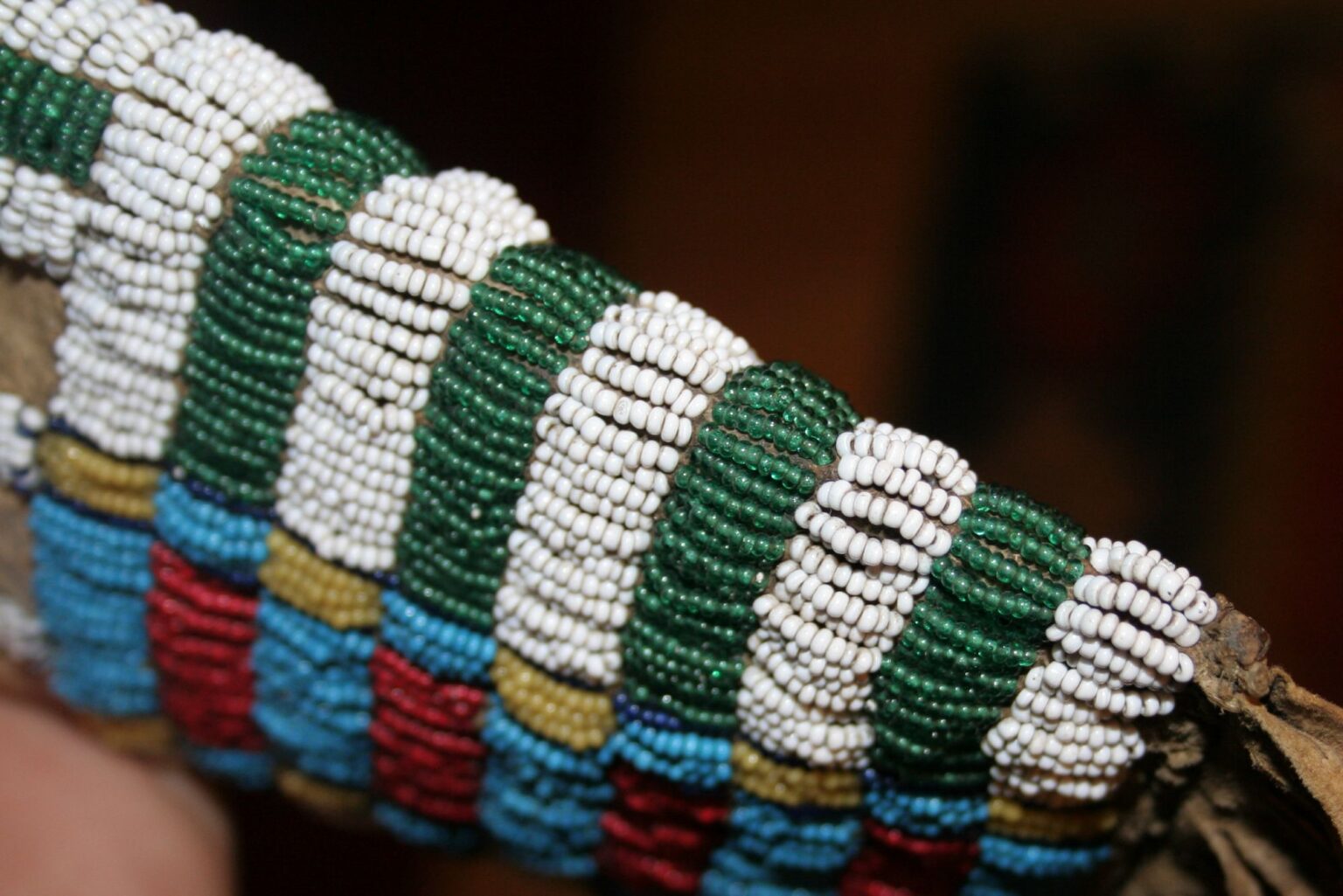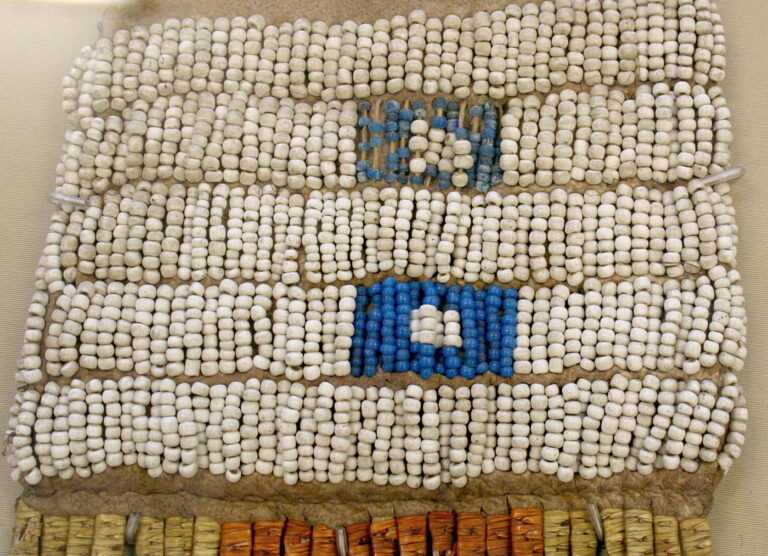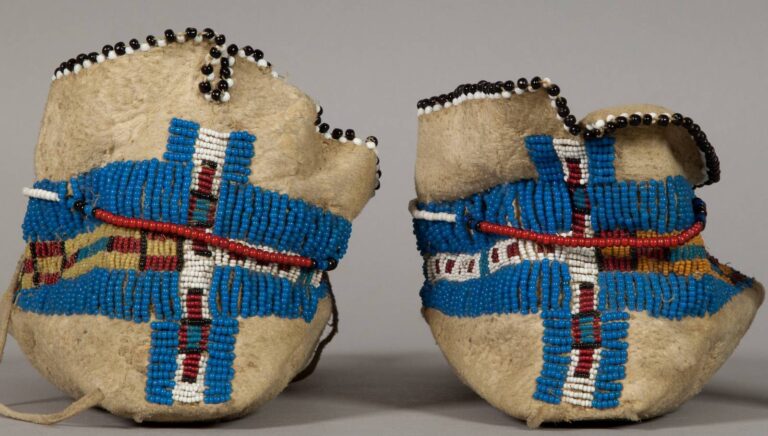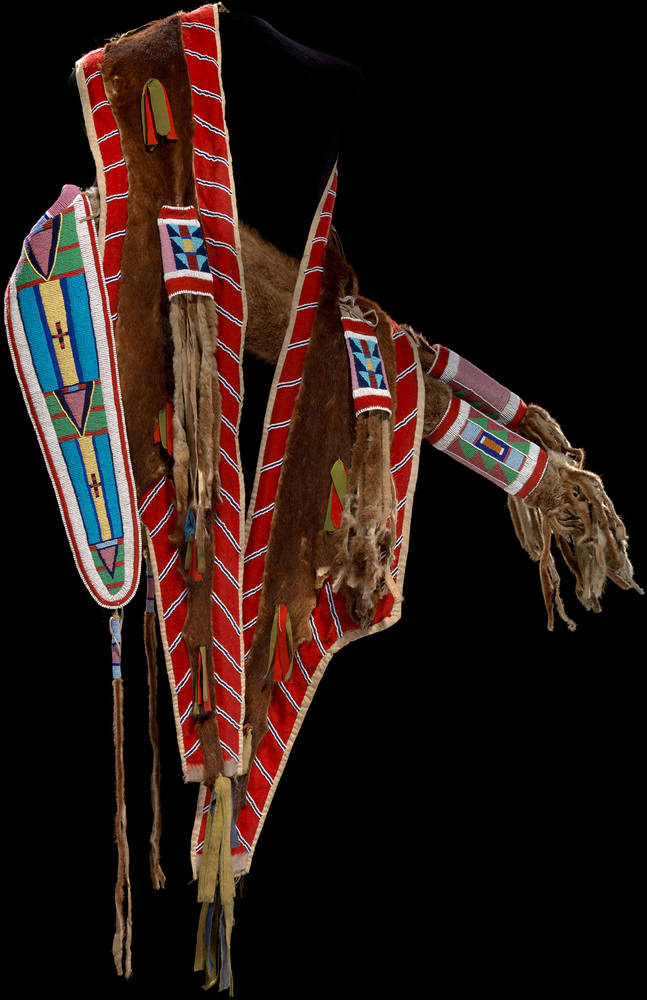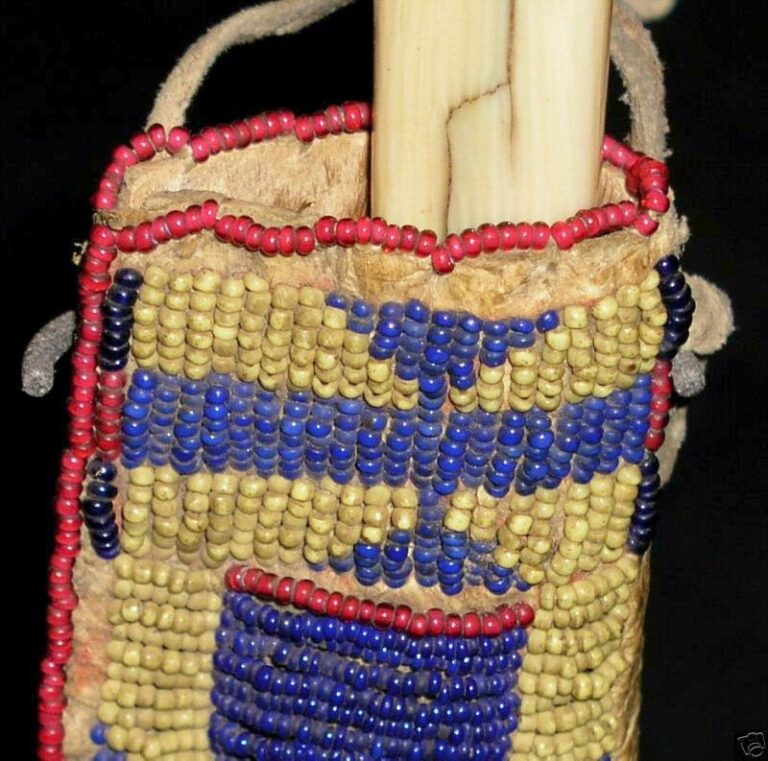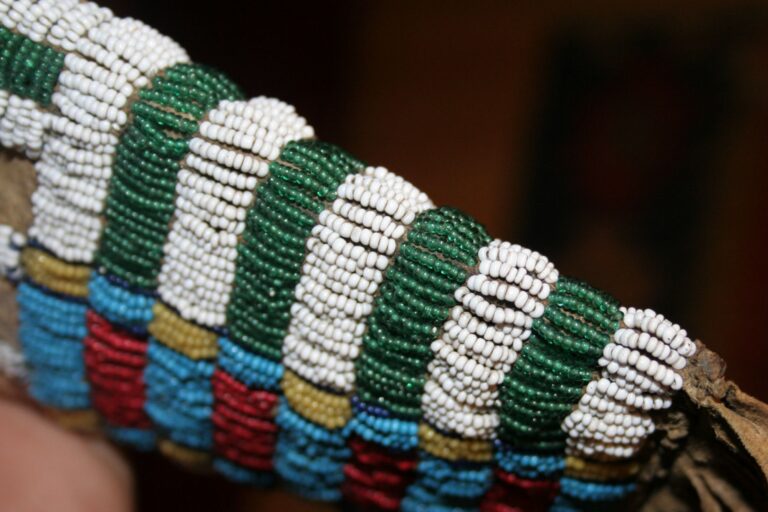Beads manufactured nowadays differ from those made one or two hundred years ago, particularly thanks to the change of manufacturing technologies. Period American Indian beads, as well as European artifacts from 19th century, differ from modern in colour, shades and shape.
All beads used by American Indians for their beadwork during American colonial times were of European origin and made of glass. American Indians never made beads themselves, as laymen sometimes claim. In Europe, beads were used for producing bijou, embroidering pictures (pictures of saints for example) and sometimes tables were decorated with beadwork, as well as handbags and other items.
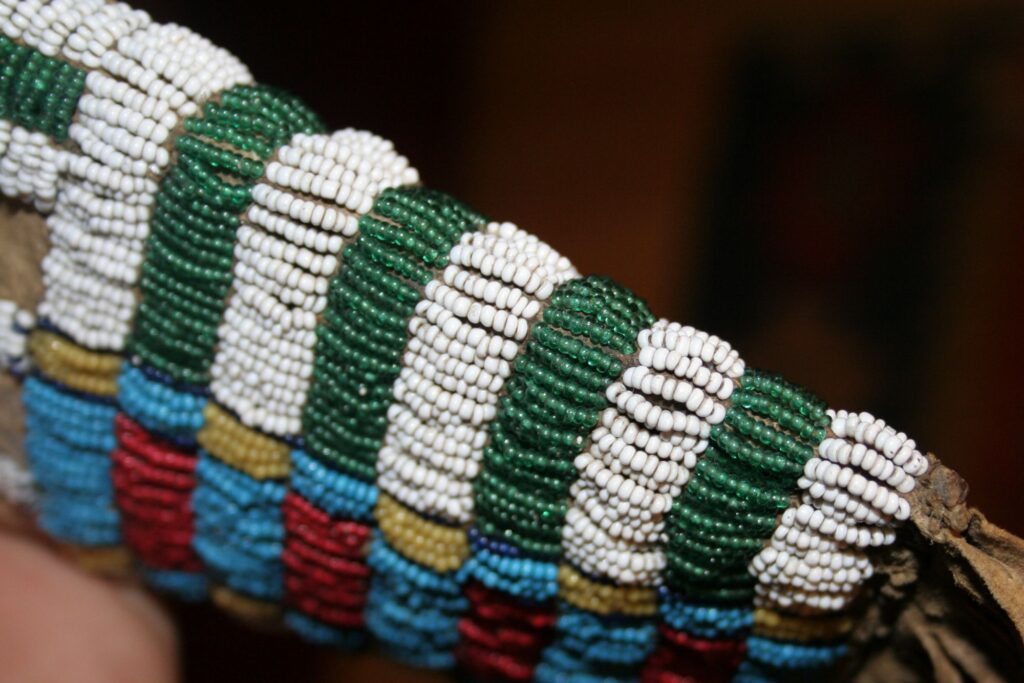
A large part of European bead production was intended for trading with the “savages”, particulary blacks in Africa, Amercan Indians in North America, India and other countries. European bead exports reached thousands of tons annually.
The most famous and productive European centres of bead production were italian Venice, the Murano islands and area of Jablonec nad Nisou (Gablonz an der Neiße) in Bohemia. All are still in business today.
Pony beads
The oldest beads, that plains Indians incorporated into their embroideries were so called “pony beads”. They gained their name because the white traders brought them on horses or ponies, or that they came to the Indians around the same time as horses.
Pony beads reached the Great plains area during the second half of the 18th century,mainly thanks to French merchants. However, they did not become widespread until the first half of the 19th century. They were not sold in small bags as today, but threaded onto linen strings. Each thread or string measured about 30-40 cm, was folded at half, tied at the ends, creating a loop, and several such loops were made into one sheaf.
Pony beads colors
The oldest pony bead colors were various shades of powder blue and chalk white. Red with white core, transparent red, transparent green, night blue (almost black), black, greasy yellow, corn and other colors came later. As pony beads were scarce at the beginning, they were first used in limited numbers, mostly in single lines, often just to border quillwork areas. Later, larger areas were embroidered completely with pony beads, for example knife sheaths, baby cradles, robe or blanket stripes, etc.

Pony beads size
The diameter of pony beads can vary from about 2,5 mm to 3,7 mm. That corresponds with contemporary marking from 6/0 to 9/0 (the number states, how many bead rows fit to the width of one inch). Due to the size of those beads and also their limited range of color, the pony bead embroideries can look a bit awkward or crude.
This is also reason that distinguishing among various tribal styles can sometimes be difficult. From the fifties of the 19th century, pony beads were in decline, as they were replaced by smaller “seed beads“.
Seed beads
In the 40’s, but primarilly the 50’s of the 19th century, the era of seed beads came into fashion. Seed beads are smaller than pony beads, about 2mm in diameter, which correspond to present markings from 11/0 to 13/0.
Seed beads have gradually started to displace and replace the larger and more sluggish pony beads. However, the mass spread of seed beads did not occur immediately, but only a few decades later, sometime during the 1860s.
Seed beads appeared in wider color ranges than pony beads (some studies mention up to 80 shades). Seed bead embroideries are finer, more colourfull, and it is possible to experiment more with patterns. Various distinctive tribal styles and beadwork techniques developed with the arrival of seed beads. The second half of the 19th century is the era of seed bead embroideries flowering, so quillwork was somehow sidelined.
The seed beads imported to America remained primarily from Italy and the Austro-Hungarian empire, and to a smaller extent from France, Netherlands and Belgium. In the reservation period, particularly during the 80’s, Bohemian beads prevailed. They were of brighter colours and more even shapes than Italian beads.
Beads shapes
One of two main features distinguishing period beads from contemporary production is their shape. In the 18th and 19th century, beads were manually cut off long glass pipes with long iron wires in the center (bead hole). The results were somehow irregulary thick and sometimes not very even beads with quite sharp edges. Although the edges were somehow rounded in later manufacturing processes, they often kept their uneven, narrow and angular shapes.
If we observe the beadwork from above, the beads form rectangles and trapezoids with slightly rounded edges (fig. a) or resemble variously thick cylinders (fig b). A particularly irregular shape is very characteristic for period beads.
As time moved on, the manufacturing was more sophisticated and the bead shapes became more round and even (fig. c) until it reached its present form (fig d).
Period beads colours
The main difference among modern and period beads is in their colour. Modern shades are obtained synthetically, and are therefore showier, flashier, have a more “synthetic” look. The variety of bead colors available today is also much wider than it was during the 19th century. Thus it is very hard to find beads that are at least similar to those manufactured during the 19th century, both, regarding their shape and proper colour shade.
Let’s take a closer look at individual colour shades of beads, which appeared during the 19th century. All colour markings were only very rough. It is neccessary to realize that each colour could include many variants, shades and mutations, as various manufacturers used different technologies, which even differed over time.
White
Greasy yellow
The most prominent yellows were various shades of so called greasy yellow. Greasy yellow is colour of rancid butter. The greasy yellow could vary from very soft and pale shades to quite bright yellow.
Old yellow
A distinctive yellow color, sometimes it can be very similar to a greasy yellow, or a shade that is somewhere on the spectrum between the two. Size-wise it appears only as seed beads. Rarely used in embroidery for larger areas.
Orange
Colour of rippened corn. Could appear in various shades. It came in pony and seed size.
Pink
A very important shade indispensable for some tribes (for example the Crows). Old rose tended to be rather more violet than orangish. Modern pink beads tend to have a rather orangish tinge. It appeared mainly as seed beads, less as pony beads. It is again very difficult to get good quality reproductions of pink seed beads.
Red white inside
Plain red beads did not exist in the 19th century. Only red with white centers and dark, transparent red were made. Red white inside beads are characterized by their red surface and white central parts. Sometimes they are called “white hearts”. They appeared both in pony and seed beads.
The red beads on originals are rather darker, with a brownish or violet tinge. Some shades of red white inside can tend to be a little bit pinkish. Even nowadays, white heart beads are produced, but the colour is much more bright, showy and flashy than we can see on originals.
Transparent red
The red white inside were by far the most typical red beads used during the 19th century. Marginally transparent red beads could be employed. They were usually very dark, but some shades can be lighter.
Transparent pink
A transparent color, similar to the transparent red but it is lighter with a strong hint of pink-purple. It was relatively uncommon and occurred only in a smaller variant (seed beads).
Pale blue
The lightest shades of blue colored beads range from almost white with blueish tinge to darker shades. This color existed only in seed variants. Sometimes those beads are called “Sioux blue”.
Sky blue
There were many sky blue shades. They were very universaly employed, from usage as background colour up to part of transmontane style.
Powder blue
A key colour, especially for older pony beads. It was one of the first colours ever made. It played a main role, along with white, when the first pony bead decorations were made. Made in both seed and pony beads, powder blue is a middle or darker blue, which is often semi-transparent. Sometimes this color is also called “Bodmer blue”.
Navy blue
The navy blue colour was mainly found in seed beads. It appeared in a range of shades. Some variants could be also transparent, fully or partially.
Dark blue
The dark blue looks like black at first glance, but it is not black, it is an extremely dark shade of blue. This blue tint is often only visible in good light, otherwise it appears black. It is also sometimes called “Cheyenne blue”, “night blue”or “midnight blue”. This color has appeared among both pony beads and seed beads.
“Arapahoe blue” is a particular color variation of dark blue. It is transparent and slightly lighter. Both colours can only be distinguished in good light, otherwise they both appear black.
Transparent green
Mostly occured in darker shades, only marginally lighter shades can be found. It occurred mostly in smaller size (seed beads).
Middle green
A wide scale of shades, from powder green to khaki. It occurred rather marginally.
Acquisition options
There are limited options for acquiring beads that are really old (19th century), or that are newly made and at least look old. The more the beads resemble the old ones, the more expensive they are. The most expensive are the originals, which are also hard to come by. They are usually sold by the gram or ounce.
The price of original beads ranges from about 200 to 1250 USD per kilo. The price for high quality reproductions ranges from about 50 to 250 USD per kilo.
The Beadmatch is one of the largest suppliers of original Italian beads. However, warehouses are limited and the beads are extremely expensive; they are usually purchased only by restorers of period originals, for whom such an investment is worthwhile.

